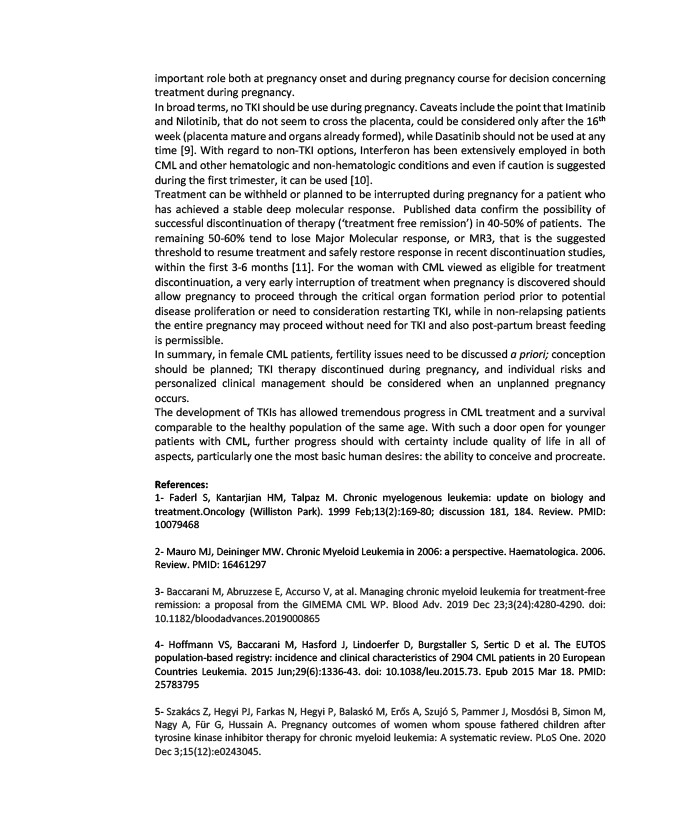
important role both at pregnancy onset and during pregnancy course for decision concerning
treatment during pregnancy.
In broad terms, no TKI should be use during pregnancy. Caveats include the point that Imatinib
and Nilotinib, that do not seem to cross the placenta, could be considered only after the 16th
week (placenta mature and organs already formed), while Dasatinib should not be used at any
time 9. With regard to non-TKI options, Interferon has been extensively employed in both
CML and other hematologic and non-hematologic conditions and even if caution is suggested
during the first trimester, it can be used 10.
Treatment can be withheld or planned to be interrupted during pregnancy for a patient who
has achieved a stable deep molecular response. Published data confirm the possibility of
successful discontinuation of therapy (‘treatment free remission’) in 40-50% of patients. The
remaining 50-60% tend to lose Major Molecular response, or MR3, that is the suggested
threshold to resume treatment and safely restore response in recent discontinuation studies,
within the first 3-6 months 11. For the woman with CML viewed as eligible for treatment
discontinuation, a very early interruption of treatment when pregnancy is discovered should
allow pregnancy to proceed through the critical organ formation period prior to potential
disease proliferation or need to consideration restarting TKI, while in non-relapsing patients
the entire pregnancy may proceed without need for TKI and also post-partum breast feeding
is permissible.
In summary, in female CML patients, fertility issues need to be discussed a priori; conception
should be planned; TKI therapy discontinued during pregnancy, and individual risks and
personalized clinical management should be considered when an unplanned pregnancy
occurs.
The development of TKIs has allowed tremendous progress in CML treatment and a survival
comparable to the healthy population of the same age. With such a door open for younger
patients with CML, further progress should with certainty include quality of life in all of
aspects, particularly one the most basic human desires: the ability to conceive and procreate.
References:
1- Faderl S, Kantarjian HM, Talpaz M. Chronic myelogenous leukemia: update on biology and
treatment.Oncology (Williston Park). 1999 Feb;13(2):169-80; discussion 181, 184. Review. PMID:
10079468
2- Mauro MJ, Deininger MW. Chronic Myeloid Leukemia in 2006: a perspective. Haematologica. 2006.
Review. PMID: 16461297
3- Baccarani M, Abruzzese E, Accurso V, at al. Managing chronic myeloid leukemia for treatment-free
remission: a proposal from the GIMEMA CML WP. Blood Adv. 2019 Dec 23;3(24):4280-4290. doi:
10.1182/bloodadvances.2019000865
4- Hoffmann VS, Baccarani M, Hasford J, Lindoerfer D, Burgstaller S, Sertic D et al. The EUTOS
population-based registry: incidence and clinical characteristics of 2904 CML patients in 20 European
Countries Leukemia. 2015 Jun;29(6):1336-43. doi: 10.1038/leu.2015.73. Epub 2015 Mar 18. PMID:
25783795
5- Szakács Z, Hegyi PJ, Farkas N, Hegyi P, Balaskó M, Erős A, Szujó S, Pammer J, Mosdósi B, Simon M,
Nagy A, Für G, Hussain A. Pregnancy outcomes of women whom spouse fathered children after
tyrosine kinase inhibitor therapy for chronic myeloid leukemia: A systematic review. PLoS One. 2020
Dec 3;15(12):e0243045.